
Lithops is a genus of succulent plants in the ice plant family, Aizoaceae. Members of the genus are native to southern Africa. The name is derived from the Ancient Greek words λίθος 'stone' and ὄψ 'face', referring to the stone-like appearance of the plants. They avoid being eaten by blending in with surrounding rocks and are often known as pebble plants or living stones. Lithops is both the genus name and the common name. The formation of the name from the Ancient Greek -ops means that even a single plant is called a Lithops.

The conservation status of a group of organisms indicates whether the group still exists and how likely the group is to become extinct in the near future. Many factors are taken into account when assessing conservation status: not simply the number of individuals remaining, but the overall increase or decrease in the population over time, breeding success rates, and known threats. Various systems of conservation status are in use at international, multi-country, national and local levels, as well as for consumer use such as sustainable seafood advisory lists and certification. The two international systems are by the International Union for Conservation of Nature (IUCN) and The Convention on International Trade in Endangered Species of Wild Fauna and Flora (CITES).

The spotted tilapia, also known as the spotted mangrove cichlid or black mangrove cichlid, is a species of fish of the cichlid family. It is native to fresh and brackish water in West and Central Africa, but has been introduced to other regions where it is considered invasive.
The evergreen forest warbler or Cameroon scrub-warbler is a grass warbler species in the family Locustellidae. It was formerly included in the "Old World warbler" assemblage.

The Moheli brush warbler is a species of Old World warbler in the family Acrocephalidae. It is found only in Comoros. Its natural habitat is subtropical or tropical moist montane forests.
Nymphargus mariae, commonly known as Maria's giant glass frog, is a species of frog in the family Centrolenidae. It is found in the cloud forests of the Serranía de Sira, Huánuco, Peru and in Ecuador. A population endemic to Ecuador was previously considered to be a distinct species, Nymphargus puyoensis, but is now classified as a junior synonym.
Hyperolius mariae is a species of frog in the family Hyperoliidae.
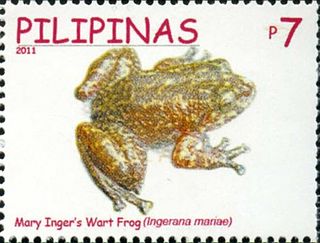
Alcalus mariae, common name Mary's frog or Palawan eastern frog, is a species of frog in the family Ceratobatrachidae. It is endemic to the Palawan Island, the Philippines, and only known from its type locality, Mount Balabag, in the Mantalingajan mountain range. The specific name refers to Mary Lee Inger née Ballew, first wife of Robert F. Inger who formally described the species in 1954.
The bigeye lates is a species of lates perch native to Lake Tanganyika and from the Lualaba drainage in the Democratic Republic of the Congo. Juveniles inhabit inshore habitats while adults inhabit benthic environments in deeper waters, being the top predator at depths of 100 metres (330 ft) and greater. It is known to make diurnal migrations to surface waters to prey on pelagic fishes. This species can reach a length of 80 centimetres (31 in) TL. This species is commercially important and is also popular as a game fish.
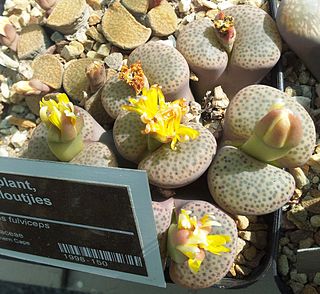
Lithops fulviceps is a species of plant in the family Aizoaceae. It occurs in a small region of southern Namibia and northern South Africa. Its natural habitats are rocky areas and cold deserts. It is threatened by habitat loss.

Lithops hermetica is a species of plant in the family Aizoaceae. It is endemic to Namibia. Its natural habitat is rocky areas. It was assessed by Lyndley Craven.
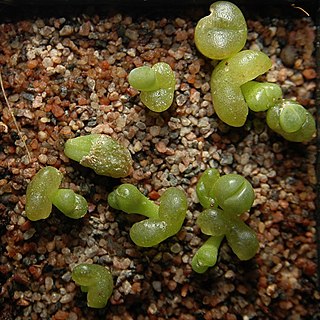
Lithops optica is a species of plant in the family Aizoaceae, endemic to Namibia.
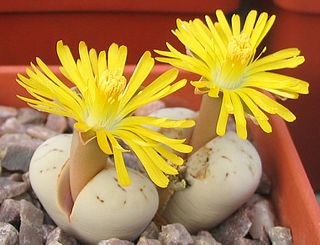
Lithops ruschiorum is a species of plant in the family Aizoaceae. It is endemic to Namibia. Its natural habitats are rocky areas and cold desert.

Lithops werneri is a species of plant in the family Aizoaceae. It is endemic to Namibia. Its natural habitat is rocky areas.
Lyndley Alan Craven was a botanist who became the Principal Research Scientist of the Australian National Herbarium.

Lithops salicola is a species of perennial plant in the family Aizoaceae, often called living stones, because of its resemblance to round grey pebbles.

Lithops francisci, commonly known as one of the living stones or pebble plants, is in the family Aizoaceae. It is endemic to the arid desert environments of Namibia. It is a succulent with a natural habitat in rocky areas. L. francisci was assessed by Nicholas Edward Brown in 1925. It is one of the Lithops plants and shares the characteristic bi-leaf head pattern separated by a deep fissure, the bottom of which houses and protects the stunted stem.
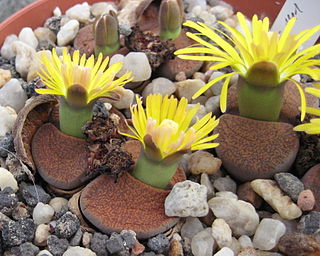
Lithops lesliei is a species of plant in the family Aizoaceae. The plant is collected for its medicinal properties, and has therefore become threatened.
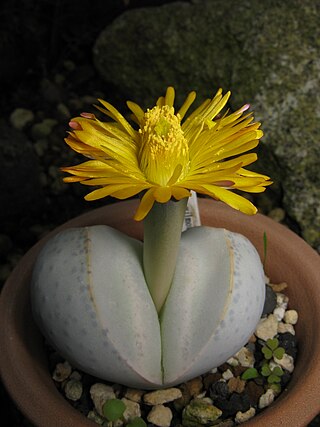
Dinteranthus is a genus of plants in the family Aizoaceae. It occurs in the arid northwestern parts of the Northern Cape Province, South Africa and the south-eastern parts of Namibia.















